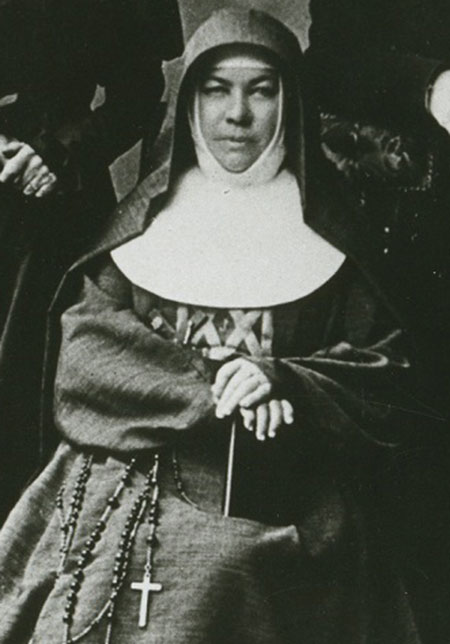WHAT MADE MARY MACKILLOP A SAINT FOR AUSTRALIA?

[Above: Mary MacKillop in 1890, public domain]
ON THIS DAY, 8 AUGUST 1909, Mary MacKillop died in Sydney, Australia, eight years after suffering a debilitating stroke. Cardinal Moran, the Archbishop of Sydney, reportedly said after his final visit to her bedside, “This day I consider I have assisted at the death bed of a saint.”
Evidently he was not mistaken. In 2010, Mary MacKillop (Saint Mary of the Cross) became Australia’s first native-born saint. Her path to sainthood was not paved with roses (although a plant breeder later developed and named a rose for her). Opposition to her had sometimes been fierce. Once she was even excommunicated on false charges. Nonetheless she persevered in doing good. As a result, in 1995 Pope Paul II beatified her and in 2010 Pope Benedict XVI canonized her. In 2013 she was named patron saint of Australia.
What had Mary done to deserve both excommunication and canonization?
Born in New South Wales in 1842, she received a sporadic education. Her father was well-educated but impractical and a failure at farming. By the time she was fourteen, Mary had to work at a stationery store to support the family on her small wages. In 1860, twenty-two year-old Mary became a governess in Penola, South Australia, and taught a number of neighborhood children. There she met Father Woods who would play a pivotal role in her later work.
She was already determined to help the poor, especially through education. Meanwhile the State of Victoria had been carved out of New South Wales. In 1862 McKillop returned to Victoria and taught in local schools until establishing a boarding school in 1864. While she was there, Father Woods invited her back to South Australia to conduct Catholic education with two of her sisters.
Mary agreed and, with the help of one of her brothers, converted a stable into a school. Soon other women joined to help with the teaching. Dressed in simple black habits they called themselves the Sisters of St Joseph of the Sacred Heart (Josephites). At the invitation of Bishop Shiel, they opened a school in Adelaide, the first Australian religious institute founded by native-born Australians. The educational work spread to other regions of Australia and branched out to include orphanages, women’s protective services, and assistance for impoverished aged people, neglected children, the sick, and delinquents. By 1867, the Josephites had adopted a plain brown habit that earned them the nickname “brown Joeys.” Rather than live in convents, they lived in the communities they served.
At this point Bishop Shiel was in poor health. Father Charles Horan gained influence over him and urged changes that would have left the Sisters of St. Joseph homeless. When Mary did not accede to these demands, Bishop Shiel excommunicated her for insubordination. A few months later, shortly before his death, he rescinded the excommunication. Mary then traveled to Rome to obtain papal approval of the Josephite rules, which would give them additional protection against the interference of clergymen such as Horan. There were many who opposed her work, some because they wanted more control over it (the order required its superior to come from its own ranks), others because the Josephites refused to accept children of the affluent, refused to teach music, and refused to accept government funding.
Despite all the impediments and its determined reliance on alms, the Josephites’ work expanded to form dozens of schools. It even crossed the ocean to New Zealand.
Recognition for Mary MacKillop grew after her death, with colleges named for her as well as the breed of roses already mentioned. So many people took earth from her grave at Gore Hill Cemetery that it became necessary to exhume her body and transfer it to a vault in a memorial chapel.
—Dan Graves
----- ----- -----
For more about depictions of modern saints in Catholicism, read "Picturing saints."





